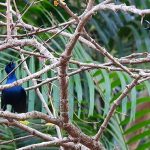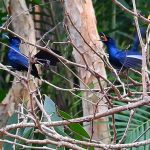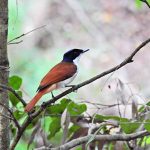SHINING FLYCATCHER
The Shining Flycatcher is a small-sized bird, measuring about 15 cm in length. The adult male has glossy black plumage with a shining blue sheen on the upperparts, while the underparts are black with a white vent. The female has similar features but with duller colours, predominantly dark grey or blackish-brown.
The species is endemic to Australia and can be found in various parts of the country. Its range extends across the northern and eastern regions, including Queensland, New South Wales, and the Northern Territory.
Shining Flycatchers inhabit a range of forested habitats, including rainforests, woodlands, and eucalypt forests. They can also be found in suburban gardens and parks with suitable vegetation.
These birds are known for their active and agile flight as they dart and hover in search of flying insects, their primary food source. They are often observed perching on exposed branches or tree trunks, sallying forth to catch insects in mid-air.
Shining Flycatchers breed during the Australian spring and summer, from September to February. They construct cup-shaped nests made of twigs, bark strips, and other plant materials. The nests are typically placed in tree forks or on horizontal branches. Females lay 2 to 4 eggs, which are incubated by both parents.
The male Shining Flycatcher has a melodious song consisting of repeated musical notes, while the female produces a series of quiet, high-pitched chirps. Both sexes use vocalizations to communicate and defend their territories.
Habitat loss, fragmentation, and introduced predators can pose challenges to their population.



